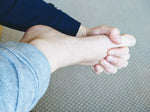Walk more stable and freer in your head with the 'Get to Know Your Toes' technique
Small treats for your feet lead to big rewards. Feet are one of the least used and at the same time most important parts of your body. So the time you spend on this is never in vain. Get to know your toes is a simple technique that clears your mind and brings out the sun. High time to take it to the league.
This simple stretching and massage combination can help you become better grounded, calmer, or more zen and focused. It helps with insomnia, tired feelings and when you are a little down.
It can also improve the damage done by years of wearing heels and footwear with a too narrow forefoot. This will make you walk more stable.
It helps with the transition to wearing minimalist barefoot shoes so that you have pain-free feet for years to come.
Have you ever noticed how often shoes are narrower than the width of your forefoot? Regardless of the reason, wearing these types of shoes for years leads to semi-permanent compression of your toes, metatarsals and also affects the reflex zones of your head and certain acupuncture points.

Get to know your toes, get started with this technique
Cut your toenails.
Stand barefoot and feel how your feet touch the ground and where they don't. Walk around barefoot for half a minute to experience how you walk and where your feet touch the ground and where they don't.
Sit on a chair or on the floor and place your left foot on your right thigh. Place the palm of your right hand against the sole of your left foot. Gently wiggle your fingers between your toes. If it is very tight, do this slowly and be patient, do not force anything. Let your fingers rest between your toes for 4 breaths. If you can do a little more and once your fingers are in place, spread your fingers and toes at the same time. Massage the toes while your fingers are between them, wriggling your fingers up and down between the toes. If you can go even further, place your fingers even deeper between your toes, towards the connection with the foot.

Then stand barefoot again and feel your feet touching the ground, walk around for half a minute and feel the difference. Feel how the ball of your left foot and your toes have more grip on the ground and that this makes you walk more stable and make more contact with the ground. Repeat the exercise with your right foot.
Milder version of the meet your toes
During pedicures they sometimes use toe spreaders so that they can apply the nail polish better. If you can't get your fingers between your toes, you could try this. Maybe someone you know can borrow one for you temporarily.
Get to know your toes from a reflexology perspective
By practicing the 'get to know your toes' technique you also stimulate reflex zones around your head, such as your eyes, ears, neck, sinuses and teeth. By stimulating these reflex zones you can become better grounded, calmer and more focused.
Get to know your toes in traditional Chinese medicine
The get to know your toes technique stimulates various acupuncture points, specifically 4 Jing well points on the foot. Spleen 1, Liver 1, Stomach 45 and Gallbladder 44. These points calm your mind and are the origin of Qi and Blood.
Stimulating these acupuncture points helps with the following ailments:
- bleeding problems such as blood in the urine and blood in the stool, dreams with worries and depression (Spleen 1)
- loss of consciousness, swollen genitals, bleeding during menstruation, lethargy (Liver 1)
- headache, toothache, facial pain, sore throat, manic depression, irritability or insomnia, excessive dreaming, insomnia combined with nightmares (Stomach 45)
- problems with the sensory organs (eyes, ears, nose, mouth, tongue) such as pain and inflammation in this area, a stiff tongue and speech problems (Gallbladder 44).
Get to know your toes clears up a lot, it clears the clouds in your head and brings out the sun.
Would you like more foot yoga exercises with an explanation of the reflex zones and effects within traditional Chinese medicine? Then take a look at:
calf stretch for heel spurs, lower back pain, headache, hemorrhoids and abdominal pain .
